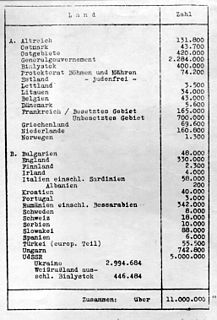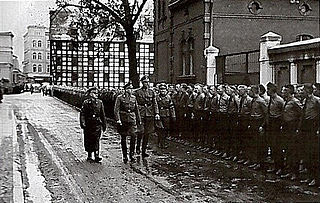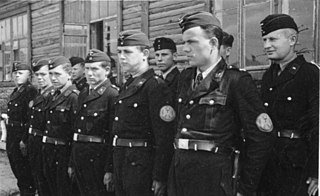 W
W29th Waffen Grenadier Division of the SS “RONA” was a collaborationist formation composed of Soviet nationals from the territory of the Lokot Autonomy in Axis-occupied areas of the RSFSR in the Soviet Union during the German–Soviet War of 1941−45.
 W
WThe Byelorussian Auxiliary Police was a collaborationist paramilitary force established in July 1941. Staffed by local inhabitants from German-occupied Byelorussia, it had similar functions to those of the German Ordnungspolizei in other occupied territories.
 W
WThe Holocaust in Estonia refers to the Nazi crimes during the occupation of Estonia by Nazi Germany. Prior to the war, there were approximately 4,300 Estonian Jews. After the Soviet 1940 occupation about 10% of the Jewish population was deported to Siberia, along with other Estonians. About 75% of Estonian Jews, aware of the fate that awaited them from Nazi Germany, escaped to the Soviet Union; virtually all of those who remained were killed by Einsatzgruppe A and local collaborators before the end of 1941. Roma people of Estonia were also murdered and enslaved by the Nazi occupiers and their collaborators. The Nazis and their allies also killed around 6,000 ethnic Estonians and 1,000 ethnic Russians who were accused of being communist sympathizers or the relatives of communist sympathizers. In addition around 15,000 Soviet prisoners-of-war and Jews from other parts of Europe were killed in Estonia during the German occupation.
 W
WThe HIPO Corps was a Danish auxiliary police corps, established by the German Gestapo on 19 September 1944, when the Danish civil police force was disbanded and most of its officers were arrested and deported to concentration camps in Germany. The majority of HIPO members were recruited from the ranks of Danish Nazi collaborators. The word HIPO is an abbreviation of the German word Hilfspolizei.
 W
WThe Holocaust in Latvia refers to the war crimes committed by Nazi Germany and collaborators victimizing Jews during the occupation of Latvia.
 W
WLatvian Auxiliary Police was a paramilitary force created from Latvian volunteers by the Nazi German authorities who occupied the country in June 1941. It was part of the Schutzmannschaft (Shuma), native police forces organized by the Germans in occupied territories and subordinated to the Order Police. Some units of the Latvian auxiliary police were involved in the Holocaust. One of its units, the Arajs Kommando, was notorious for killing 26,000 civilians during the war, mostly Jews, but also Communists and Romas.
 W
WThe Nachtigall Battalion, also known as the Ukrainian Nightingale Battalion Group, or officially as Special Group Nachtigall, was the subunit under command of the German Abwehr special operations unit Lehrregiment "Brandenburg" z.b.V. 800. Along with the Roland Battalion it was one of two military units formed February 25, 1941 by head of the Abwehr Wilhelm Franz Canaris, which sanctioned the creation of the "Ukrainian Legion" under German command. It was composed of volunteer "Ukrainian nationalists," Ukrainians operating under Stephan Bandera's OUN orders.
 W
WThe Schutzmannschaft or Auxiliary Police was the collaborationist auxiliary police of native policemen serving in those areas of the Soviet Union and the Baltic states occupied by Nazi Germany during World War II. Heinrich Himmler, head of the SS, established the Schutzmannschaft on 25 July 1941, and subordinated it to the Order Police. By the end of 1941, some 45,000 men served in Schutzmannschaft units, about half of them in the battalions. During 1942, Schutzmannschaften expanded to an estimated 300,000 men, with battalions accounting for about a third, or less than one half of the local force. Everywhere, local police far outnumbered the equivalent German personnel several times; in most places, the ratio of Germans to natives was about 1-to-10.
 W
WSchutzmannschaft-Brigade Siegling was a Belarusian Auxiliary Police brigade formed by Nazi Germany in July 1944 in East Prussia, from members of six local volunteer battalions of Schutzmannschaft following the Soviet Operation Bagration. The six retreating collaborationist units who joined Siegling included Bataillon 57 (ukrainische), Bataillon 60 (weißruthenische), Bataillon 61, 62, 63 (ukrainische), and Bataillon 64 (weißruthenische).
 W
WSelbstschutz is the name given to different iterations of ethnic-German self-protection units formed both after the First World War and in the lead-up to the Second World War.
 W
WThe Ukrainische Hilfspolizei or the Ukrainian Auxiliary Police was the official title of the local police formation set up by Nazi Germany during World War II in Reichskommissariat Ukraine, shortly after the German conquest of the Ukrainian Soviet Socialist Republic in Operation Barbarossa against the Soviet Union, Germany's former co-belligerent in the invasion of Poland.